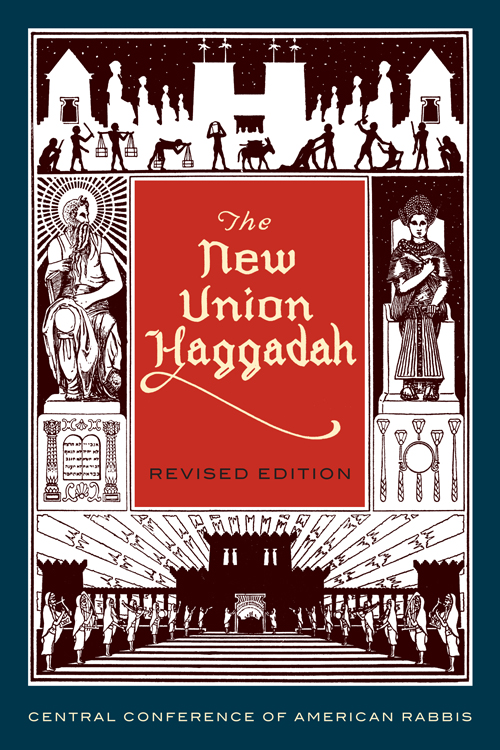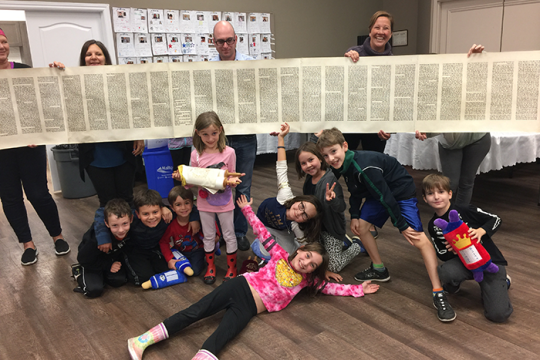
As we approach the celebration of Passover this year, a new resource and opportunity to experience the timeless meaning of our Festival of Freedom will be available for American Reform Jews. In cooperation with the Society for Classical Reform Judaism, the Central Conference of American Rabbis (CCAR) has just published The New Union Haggadah – a contemporary revision of the beloved 1923 liturgy that was cherished by generations of families in our Movement. As the editor of this project, I am privileged to share some insights on its approach and significance.
This New Union Haggadah represents an important milestone in the long tradition of liturgical innovation of the Central Conference of American Rabbis. The major focus of the CCAR's publications program since its founding in 1889 has been the creation of new worship materials in response to the dramatic cultural, social, and spiritual developments of our time. The Conference's recent prayer books, Gates of Prayer (1975), Mishkan T'filah (2007), and other resources have reflected the dominant trend toward a reappraisal and embrace of traditional Jewish ritual observance in the Reform Movement. A more recent development has been a renewed appreciation for Reform Judaism's distinctive liturgical heritage. There is a new recognition that the lyrical cadences and majestic phrases of our earlier prayer books remain beloved by many of our people, and are the common tradition and shared legacy of all Reform Jews, on every point of the spectrum. There is an emerging trend that affirms the broad diversity of worship styles and approaches to observance in our congregations. This New Union Haggadah seeks to reflect this pluralism.
This volume preserves the literary beauty, the direct and accessible text, and the broad, universalistic spirit that rendered the 1923 version the longest-lived publication in CCAR history. It's stylistic and theological embodiment of the Classical Reform spirit remains cherished by many Reform Jewish families who lovingly used it for generations, and who have continued to conduct the seder from tattered, wine-stained copies of the long out-of-print gray-covered volume. We have rendered the majority of the English text in contemporary, inclusive, gender-neutral language. In the spirit of Classical Reform, this Haggadah is conceived to be used as a forthrightly and primarily English language experience – with all of the major Hebrew texts included in transliteration, and accompanied by versions of the most popular holiday songs and hymns that may be sung in both languages.
We have introduced new elements in the text as well. These include traditional parts of the Haggadah that were consciously eliminated by the editors of the earlier version, such as the enumeration of the Ten Plagues and the tradition of welcoming of the Prophet Elijah. We have reinstated the recollection of the plagues, retaining the beautiful and moving interpretation originated by Rabbi Herbert Bronstein in the 1974 CCAR Haggadah, linking the recitation of the plagues to the symbolism of the diminishing of our joy as we recall the sufferings of our oppressors.
Despite rationalist objections, Elijah remained stubbornly ensconced in the hearts of most Reform Jews. For the ceremony of Opening of the Door for the Prophet, we have reclaimed a little-known supplement created in 1942 by the Joint Committee on Ceremonies of the CCAR and the Union of American Hebrew Congregations (now the Union for Reform Judaism) that brilliantly recasts this beloved tradition in the universalistic spirit of Reform Judaism, as an authentic question and answer dialogue between parent and child. In addition, we have incorporated more recent innovations that have broadened the embrace and symbolism of the seder – the Cup of Miriam and the Orange on the Plate – with explanations that express the heightened awareness and contemporary embrace of the diversity of our families and congregations in these popular rituals, in a way that complements the rest of the text.
Another aspect of the 1923 Union Haggadah that we have preserved is its unique artistic design that captured the imaginations of generations of Reform families. The distinctive black and white Art Deco borders and lettering commissioned for that edition, drawing on ancient archeological and calligraphic motifs, are presented here in full color. We have also embellished the text with color images based on stained glass windows from Reform temples throughout the United States, depicting Passover themes and symbols.
A distinctive feature of the 1923 edition that we have renewed is the appendix collection of scholarly essays that made the Union Haggadah a rich educational resource for individual and group study. We have enlisted some of the leading academic experts in liturgy and history in the Reform Movement today to provide studies of various dimensions of the historical, textual, and cultural background of the Passover traditions.
We believe that this renewed spiritual resource of our Reform Jewish heritage will be an important alternative for many of our people seeking a Haggadah that provides a clear, accessible, "user friendly" seder experience geared primarily for adults – one that blends the timeless traditions of the Festival with progressive contemporary interpretations. For those who have loved the Union Haggadah throughout their lives, we offer a fresh encounter with a cherished family tradition. For others, such as interfaith families, seeking a distinctive option in the midst of the hundreds of currently available versions, we trust that this volume will provide a meaningful way for contemporary Reform Jews to celebrate the holiday.
We offer this effort in the hope that we have remained true to the vision of the editors of the original Union Haggadah, whose lyrical and majestic work sought to "fire our souls with a love of liberty, and rouse our hearts to greater loyalty to the Jewish people and to Israel's God of Freedom."
Rabbi Howard A. Berman is the Executive Director of the Society for Classical Reform Judaism. Rabbi Berman is the rabbi of Central Reform Temple of Boston, as well as the Rabbi Emeritus of Chicago Sinai Congregation.



